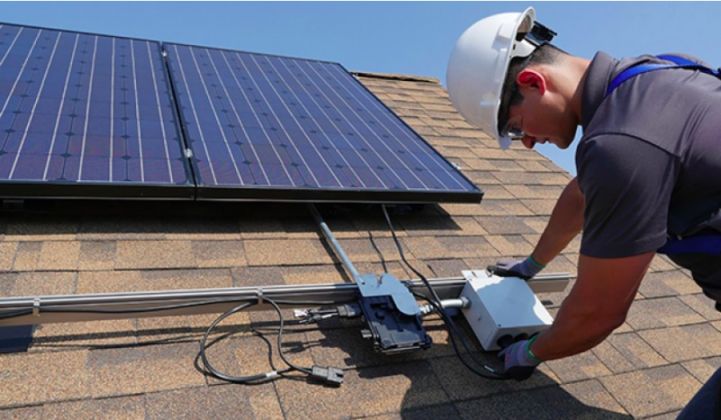Enphase Energy grew revenues and profitability in the first quarter of 2019, as its latest microinverter technology and expanding line of solar panel-integrated products continue to gain market share.
On Tuesday, the Petaluma, Calif.-based company reported first quarter net income of $2.8 million on revenue of $100.2 million, its second straight profitable quarter.
That’s an important milestone for a company that, after it created the market for microinverters and launched a successful IPO in 2010, saw fierce competition from Israel-based solar microelectronics maker SolarEdge and incumbent string inverter makers such as SMA, Fronius and ABB. Those challenges drove Enphase in 2017 to warn investors of doubts it could “continue as a going concern.”
Enphase’s losses peaked at $67.45 million for fiscal year 2016, driving a major restructuring along with layoffs, including the departure of founding CEO Paul Nahi and his replacement by former COO Badri Khotandaraman. Since then, the company’s losses have shrunk from $45.2 million on revenues of $286.2 million in 2017, to a loss of $11.62 million on revenues of $316 million in 2018 — including fourth quarter 2018 net income of $709,000, the first profitable quarter for the company.
On Tuesday’s earnings conference call, Khotandaraman pointed to the first quarter 2019 results as evidence that, “in the last 18 months, due to the hard work of a lot of people, we have turned the corner. Our balance sheet is strong, and we’ve started to make money.”
Shares of Enphase soared nearly 30 percent Wednesday morning, to about $13 per share, touching a four-year high. The company's $1.4 billion market cap has crossed a symbolic line in its competition with SolarEdge, which surpassed Enphase as the leading provider of solar panel microelectronics after its 2015 IPO, and has a market capitalization of $2.1 billion.
While Enphase ended Q1 with $78.1 million in cash, down from $102 million at the end of 2018, it also fully repaid a $39.5 million fully-secured senior term loan with Tennenbaum Capital Partners during the quarter.
And of the approximately 976,410 microinverters, or 306 megawatts DC, shipped in the first quarter, about 94 percent were the company’s latest IQ 7 technology. This ratio has gone up from 83 percent in the fourth quarter, and less than 10 percent in the first quarter of 2018. Enphase expects all shipments to be IQ 7 products by the third quarter, Khotandaraman said.
Enphase continued to see its gross margins eroded by ongoing supply constraints, Khotandaraman noted. The first quarter saw a 280 basis-point reduction in non-GAAP gross margins due to the cost of shipping key components by airplane to ensure prompt delivery, for example. But Enphase, which signed a deal with power electronics maker Infineon Technologies in March, is expecting these supply shortages to ease in coming quarters.
SolarEdge has built on its dominant position to acquire companies it can build into an integrated offering for customers. That includes energy storage systems from uninterruptible power source company Gamatronic and South Korean battery manufacturer Kokam, as well as its majority stake in Italian EV drivetrain firm SMRE. SolarEdge has also launched a grid services offering to help third-party aggregators turn installed solar systems into controllable assets — a capability that Enphase has also developed.
To compete, Enphase has branched out into multiple product lines as well. Its microinverters for higher-power solar panels continue to ship to SunPower, with expectations of North American sales to begin in the second half of 2019, Khotandaraman said. And Enphase’s microinverter-solar panel integrated AC Modules from SunPower and Panasonic continue to gain traction, although he declined to provide details.
As for energy storage, Enphase already has an AC Battery product on offer for customers in Australia, New Zealand and certain parts of Europe, and in April announced a new battery cell supplier and improved Time-of-Use (TOU) software for the product. But its primary focus for the future is its “Encharge” product, a combination of battery, inverter, related switchgear and controls, and a cloud-based software platform. It's slated for release in late 2019.
Encharge systems are expected to come in 1-kilowatt-hour, 3.3-kilowatt-hour and 13.2-kilowatt-hour configurations, with lithium-iron-phosphate batteries coming from undisclosed suppliers. Khotandaraman declined to discuss battery costs or pricing in Tuesday’s call, but did say that the company is now in the process of signing an agreement with one battery supplier, and is close to an agreement with a second.
“Those two put us in a good position as far as costs and capacity are concerned,” he said.




